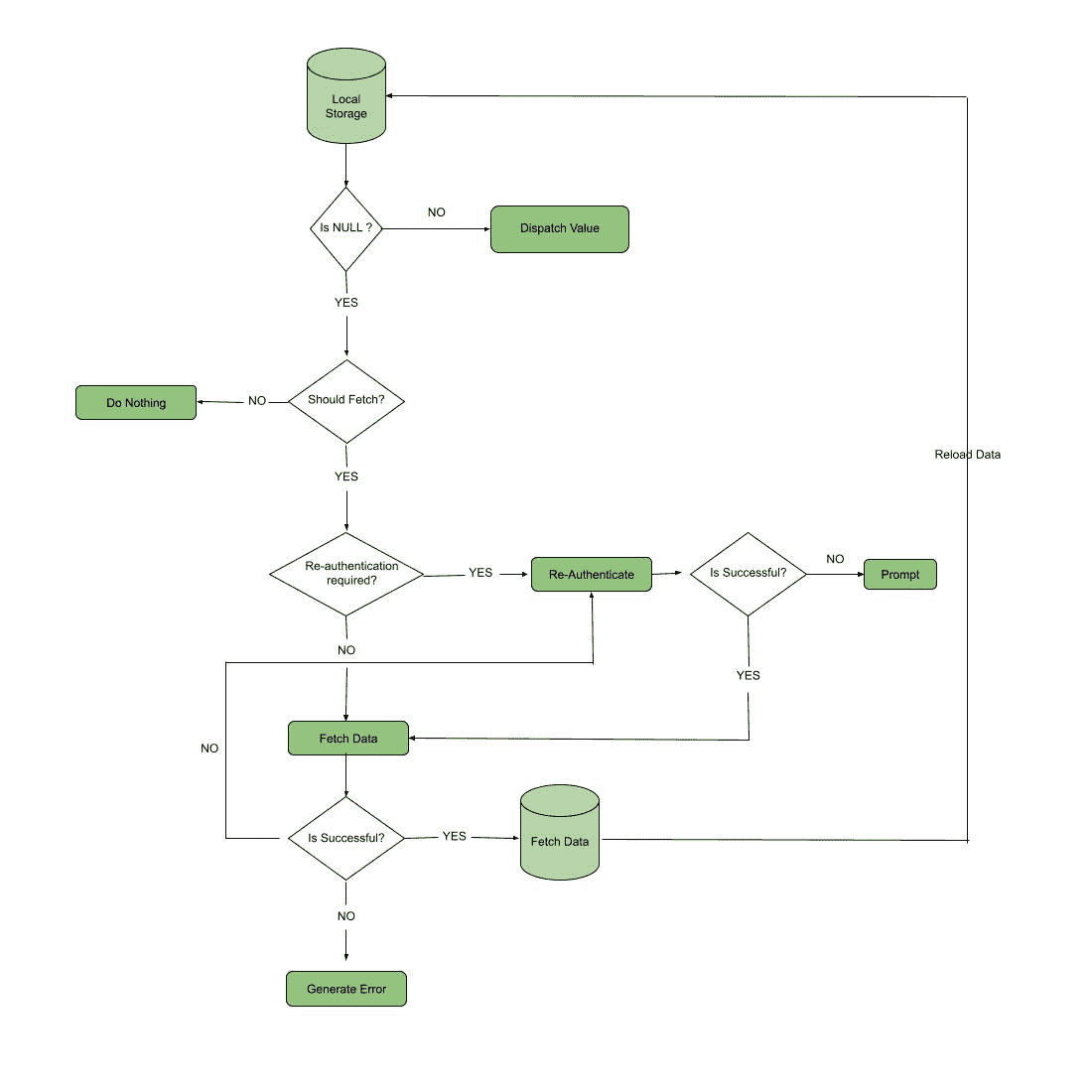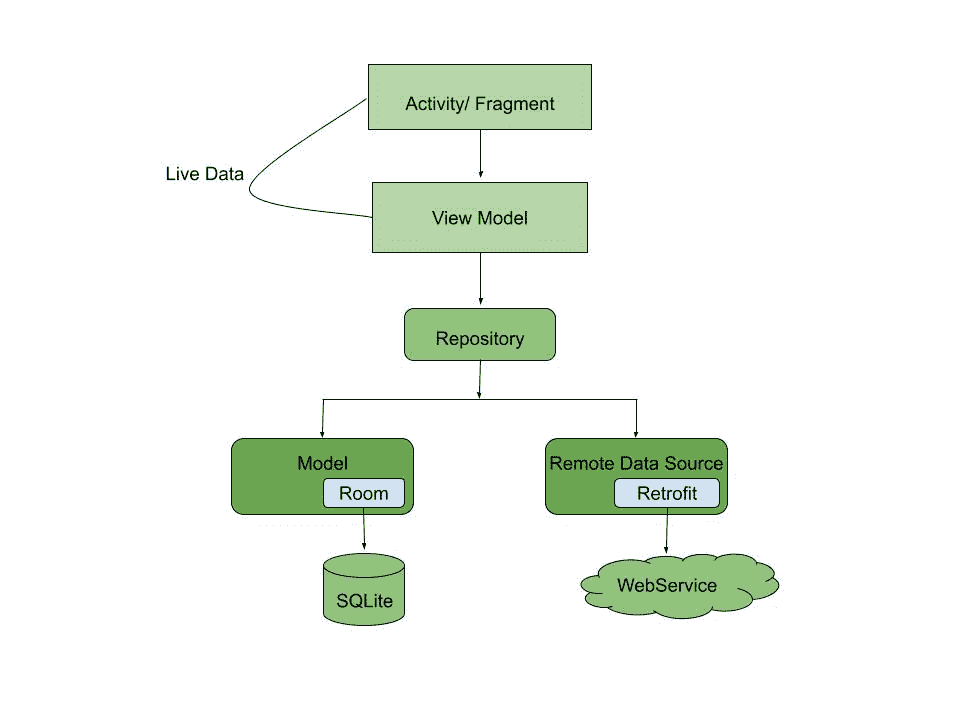如何在安卓系统中使用 NetworkBoundResource 实现离线缓存?
原文:https://www . geesforgeks . org/如何实现-离线-缓存-使用-networkboundresource-in-Android/
几乎每个需要通过网络获取数据的安卓应用都需要缓存。首先,让我们理解缓存是什么意思?我们大多数人都使用过需要从网络上获取数据的应用程序。这种采用离线优先架构的应用程序总是试图从本地存储中获取数据。另一方面,如果出现一些故障,它会请求从网络中提取数据,然后将其存储在本地,以备将来检索。数据将存储在 SQLite 数据库中。这种架构的优势在于,即使应用程序离线,我们也能够使用它。此外,由于数据被缓存,应用程序的响应速度会更快。为了处理缓存,我们将使用网络绑定资源。它是一个辅助类,决定什么时候使用缓存数据,什么时候从 web 获取数据并更新 View。它在两者之间协调。

上面的决策树显示了网络绑定资源算法的算法。
算法
让我们看看这个算法的流程:
- 每当用户以离线模式访问应用程序时,数据都会被分派到视图中,它可以是一个片段,也可以是一个活动。
- 如果磁盘中没有数据或数据不足以作为缓存,则它应该通过网络获取数据。
- 它检查是否需要登录(如果用户注销,则需要重新登录)。它会重新进行身份验证,如果成功,它会获取数据,但如果失败,它会提示用户重新进行身份验证。
- 一旦凭据匹配,它就会通过网络获取数据。
- 如果提取阶段失败,它会提示用户。
- 否则,如果成功,则数据会自动存储到本地存储中。然后刷新视图。
这里的要求是,当用户进入在线模式时,用户体验应该有最小的变化。因此,像重新认证、通过网络获取数据和刷新视图这样的过程应该在后台完成。这里需要注意的一点是,如果用户凭据发生了一些变化,如密码或用户名,用户只需要重新登录。
履行
为了更好地理解这一点,让我们构建一个应用程序。这是一个简单的新闻应用程序,它使用一个假的应用编程接口从网络上获取数据。让我们看看应用程序的高级设计:

上图是将在我们的应用程序中实现的架构的概述。这个架构是安卓推荐开发的一个现代架构良好的安卓应用。让我们开始建设这个项目。
分步实施
第一步:创建新项目
要在安卓工作室创建新项目,请参考如何在安卓工作室创建/启动新项目。注意选择科特林作为编程语言。
第二步:设置布局
总是建议首先设置布局,然后实现逻辑。所以我们将首先创建布局。如上所述,我们将从 web 服务中获取数据。由于这是一个示例项目,我们将只从随机数据生成器中获取数据。现在数据是一个汽车列表,其中包括以下属性:
- 汽车的品牌和型号
- 汽车变速器
- 汽车的颜色
- 汽车的驾驶类型。
- 汽车的燃料类型。
- 汽车的车型。
我们将使用回收视图来显示列表。因此,首先需要设计列表中每个元素的外观。接下来是名单。
可扩展标记语言
<?xml version="1.0" encoding="utf-8"?>
<RelativeLayout
xmlns:android="http://schemas.android.com/apk/res/android"
xmlns:tools="http://schemas.android.com/tools"
android:layout_width="match_parent"
android:layout_height="wrap_content"
android:layout_margin="4dp">
<!-- This will display the make and model of the car-->
<TextView
android:id="@+id/car_name"
android:layout_width="wrap_content"
android:layout_height="wrap_content"
android:layout_marginStart="8dp"
android:textColor="@color/black"
android:textSize="15sp"
tools:text="Car Name" />
<!-- This will display the transmission type of the car-->
<TextView
android:id="@+id/car_transmission"
android:layout_width="wrap_content"
android:layout_height="wrap_content"
android:layout_alignParentEnd="true"
android:layout_marginStart="16dp"
android:layout_marginEnd="16dp"
android:layout_toEndOf="@id/car_name"
tools:text="Transmission type" />
<!-- This will display the colour of the car-->
<TextView
android:id="@+id/car_color"
android:layout_width="wrap_content"
android:layout_height="wrap_content"
android:layout_below="@id/car_name"
android:layout_marginStart="8dp"
android:layout_marginEnd="8dp"
tools:text="Car colour" />
<!-- This will display the drive type of the car-->
<TextView
android:id="@+id/car_drive_type"
android:layout_width="wrap_content"
android:layout_height="wrap_content"
android:layout_below="@id/car_name"
android:layout_marginStart="8dp"
android:layout_marginEnd="8dp"
android:layout_toEndOf="@id/car_color"
tools:text="Car Drive Type" />
<!-- This will display the fuel type of the car-->
<TextView
android:id="@+id/car_fuel_type"
android:layout_width="wrap_content"
android:layout_height="wrap_content"
android:layout_below="@id/car_transmission"
android:layout_marginStart="8dp"
android:layout_marginEnd="8dp"
android:layout_toEndOf="@id/car_drive_type"
tools:text="Car fuel_type" />
<!-- This will display the car type of the car-->
<TextView
android:id="@+id/car_car_type"
android:layout_width="wrap_content"
android:layout_height="wrap_content"
android:layout_below="@id/car_transmission"
android:layout_marginStart="8dp"
android:layout_marginEnd="8dp"
android:layout_toEndOf="@id/car_fuel_type"
tools:text="Car Type" />
</RelativeLayout>
现在,让我们对列表布局进行编码:
可扩展标记语言
<?xml version="1.0" encoding="utf-8"?>
<RelativeLayout
xmlns:android="http://schemas.android.com/apk/res/android"
xmlns:tools="http://schemas.android.com/tools"
android:layout_width="match_parent"
android:layout_height="match_parent"
tools:context=".CarActivity">
<!-- The recycler view-->
<androidx.recyclerview.widget.RecyclerView
android:id="@+id/recycler_viewer"
android:layout_width="match_parent"
android:layout_height="match_parent"
android:clipToPadding="false"
android:padding="4dp"
tools:listitem="@layout/carlist_item" />
<!--Initially the app will fetch data from the
web, hence a progress bar for that-->
<ProgressBar
android:id="@+id/progress_bar"
android:layout_width="wrap_content"
android:layout_height="wrap_content"
android:layout_centerInParent="true"
android:visibility="invisible"
tools:visibility="visible" />
<!--If the application is not able to
fetch/ expose the data to the view-->
<TextView
android:id="@+id/text_view_error"
android:layout_width="wrap_content"
android:layout_height="wrap_content"
android:layout_centerInParent="true"
android:layout_margin="8dp"
android:gravity="center_horizontal"
android:visibility="invisible"
tools:text="Error Message"
tools:visibility="visible" />
</RelativeLayout>
第三步:现在我们来创建 API 包
carlispi . kt
我的锅
package com.gfg.carlist.api
import com.gfg.carlist.data.CarList
import retrofit2.http.GET
interface CarListAPI {
// Companion object to hold the base URL
companion object{
const val BASE_URL = "https://random-data-api.com/api/"
}
// The number of cars can be varied using the size.
// By default it is kept at 20, but can be tweaked.
// @GET annotation to make a GET request.
@GET("vehicle/random_vehicle?size=20")
// Store the data in a list.
suspend fun getCarList() : List<CarList>
}
第四步:实现 app 模块
模块只不过是一个对象类,它为应用程序的源代码提供了一个容器。它封装了与任务相关的数据模型。android 架构建议在视图模型中尽量少使用业务逻辑,因此业务应用程序任务在 app 模块中表示。它将包括三种方法:
- 一种通过改装调用应用编程接口的方法
- 提供列表的方法
- 一种提供数据库或者建立数据库的方法。
AppModule.kt
我的锅
package com.gfg.carlist.di
import android.app.Application
import androidx.room.Room
import com.gfg.carlist.api.CarListAPI
import com.gfg.carlist.data.CarListDatabase
import dagger.Module
import dagger.Provides
import dagger.hilt.InstallIn
import dagger.hilt.components.SingletonComponent
import retrofit2.Retrofit
import retrofit2.converter.gson.GsonConverterFactory
import javax.inject.Singleton
@Module
@InstallIn(SingletonComponent::class)
object AppModule {
@Provides
@Singleton
fun provideRetrofit(): Retrofit =
Retrofit.Builder()
.baseUrl(CarListAPI.BASE_URL)
.addConverterFactory(GsonConverterFactory.create())
.build()
@Provides
@Singleton
fun provideCarListAPI(retrofit: Retrofit): CarListAPI =
retrofit.create(CarListAPI::class.java)
@Provides
@Singleton
fun provideDatabase(app: Application): CarListDatabase =
Room.databaseBuilder(app, CarListDatabase::class.java, "carlist_database")
.build()
}
步骤 5:创建数据类
我们已经处理完了 API,从 web 服务中获取数据,但是数据存储在哪里呢?让我们创建一个类来存储数据。我们必须创建一个数据类。如果应用程序只是获取和公开数据,那么它将只有一个数据类文件。但是在这里,我们必须获取、公开以及缓存数据。因此,房间在这里开始发挥作用。所以在数据类中,我们必须创建一个实体。
CarList.kt
我的锅
package com.gfg.carlist.data
import androidx.room.Entity
import androidx.room.PrimaryKey
// Data Class to store the data
// Here the name of the table is "cars"
@Entity(tableName = "cars")
data class CarList(
@PrimaryKey val make_and_model: String,
val color: String,
val transmission: String,
val drive_type: String,
val fuel_type: String,
val car_type: String
)
由于我们将在本地缓存数据,因此需要创建一个数据库。
carlstd database . kt
我的锅
package com.gfg.carlist.data
import androidx.room.Database
import androidx.room.RoomDatabase
@Database(entities = [CarList::class], version = 1)
abstract class CarListDatabase : RoomDatabase() {
abstract fun carsDao(): CarsDao
}
因为我们已经创建了一个表,所以我们需要一些查询来从表中检索数据。这是使用 DAO 或 D ata A 访问 O 对象实现的。
carsdata . kt
我的锅
package com.gfg.carlist.data
import androidx.room.Dao
import androidx.room.Insert
import androidx.room.OnConflictStrategy
import androidx.room.Query
import kotlinx.coroutines.flow.Flow
@Dao
interface CarsDao {
// Query to fetch all the data from the
// SQLite database
// No need of suspend method here
@Query("SELECT * FROM cars")
// Kotlin flow is an asynchronous stream of values
fun getAllCars(): Flow<List<CarList>>
// If a new data is inserted with same primary key
// It will get replaced by the previous one
// This ensures that there is always a latest
// data in the database
@Insert(onConflict = OnConflictStrategy.REPLACE)
// The fetching of data should NOT be done on the
// Main thread. Hence coroutine is used
// If it is executing on one one thread, it may suspend
// its execution there, and resume in another one
suspend fun insertCars(cars: List<CarList>)
// Once the device comes online, the cached data
// need to be replaced, i.e. delete it
// Again it will use coroutine to achieve this task
@Query("DELETE FROM cars")
suspend fun deleteAllCars()
}
处理 web 服务数据和本地数据的存储库类。
CarListRepository.kt
我的锅
package com.gfg.carlist.data
import androidx.room.withTransaction
import com.gfg.carlist.api.CarListAPI
import com.gfg.carlist.util.networkBoundResource
import kotlinx.coroutines.delay
import javax.inject.Inject
class CarListRepository @Inject constructor(
private val api: CarListAPI,
private val db: CarListDatabase
) {
private val carsDao = db.carsDao()
fun getCars() = networkBoundResource(
// Query to return the list of all cars
query = {
carsDao.getAllCars()
},
// Just for testing purpose,
// a delay of 2 second is set.
fetch = {
delay(2000)
api.getCarList()
},
// Save the results in the table.
// If data exists, then delete it
// and then store.
saveFetchResult = { CarList ->
db.withTransaction {
carsDao.deleteAllCars()
carsDao.insertCars(CarList)
}
}
)
}
第六步:操作界面
记得在第 1 步,我们创建了一个 RecyclerView 来展示汽车列表。但是这项工作到现在还没有完成。我们需要制作一个适配器和一个视图模型。这两个类共同定义了数据的显示方式。
cara adapter . kt
我的锅
package com.gfg.carlist.features.carlist
import android.view.LayoutInflater
import android.view.ViewGroup
import androidx.recyclerview.widget.DiffUtil
import androidx.recyclerview.widget.ListAdapter
import androidx.recyclerview.widget.RecyclerView
import com.gfg.carlist.data.CarList
import com.gfg.carlist.databinding.CarlistItemBinding
class CarAdapter : ListAdapter<CarList, CarAdapter.CarViewHolder>(CarListComparator()) {
override fun onCreateViewHolder(parent: ViewGroup, viewType: Int): CarViewHolder {
val binding =
CarlistItemBinding.inflate(LayoutInflater.from(parent.context), parent, false)
return CarViewHolder(binding)
}
override fun onBindViewHolder(holder: CarViewHolder, position: Int) {
val currentItem = getItem(position)
if (currentItem != null) {
holder.bind(currentItem)
}
}
// View Holder class to hold the view
class CarViewHolder(private val binding: CarlistItemBinding) :
RecyclerView.ViewHolder(binding.root) {
fun bind(carlist: CarList) {
binding.apply {
carName.text = carlist.make_and_model
carTransmission.text = carlist.transmission
carColor.text = carlist.color
carDriveType.text = carlist.drive_type
carFuelType.text = carlist.fuel_type
carCarType.text = carlist.car_type
}
}
}
// Comparator class to check for the changes made.
// If there are no changes then no need to do anything.
class CarListComparator : DiffUtil.ItemCallback<CarList>() {
override fun areItemsTheSame(oldItem: CarList, newItem: CarList) =
oldItem.make_and_model == newItem.make_and_model
override fun areContentsTheSame(oldItem: CarList, newItem: CarList) =
oldItem == newItem
}
}
carlistisviewmodel . kt】的缩写
我的锅
package com.gfg.carlist.features.carlist
import androidx.lifecycle.ViewModel
import androidx.lifecycle.asLiveData
import com.gfg.carlist.data.CarListRepository
import dagger.hilt.android.lifecycle.HiltViewModel
import javax.inject.Inject
// Using Dagger Hilt library to
// inject the data into the view model
@HiltViewModel
class CarListViewModel @Inject constructor(
repository: CarListRepository
) : ViewModel() {
val cars = repository.getCars().asLiveData()
}

